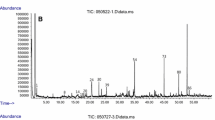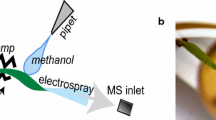Abstract
Sulfoxaflor is a new systemic insecticide developed as a replacement for older neonicotinoids which are known to be toxic to pollinators. However, its metabolism in nectar and effect on nectar biosynthesis have not been investigated. After soil and foliar application, sulfoxaflor and its main metabolites in soil, leaf and Salvia splendens nectar, were measured by liquid chromatography coupled with triple quadrupole mass spectrometer (LC-MS/MS). The chemical composition between the clean and sulfoxaflor spiked nectar were also compared. The activities of two possible sulfoxaflor detoxifying enzymes in S. splendens nectar, nitrile hydratase and glutathione-s-transferase, were measured by LC-MS and spectrophotometry. S. splendens nectar proteome was investigated by high-resolution orbitrap-based MS/MS to screen for sulfoxaflor detoxifying relevant proteins. S. splendens could absorb sulfoxaflor through root or leaf surface and secrete a proportion of sulfoxaflor along with its metabolites into the nectar. After soil application, sulfoxaflor’s low toxic metabolite X11719474 was dominant in the nectar and reached an average concentration of 8905 ppb. However, after foliar application, sulfoxaflor was dominant over its metabolites in the nectar. S. splendens nectar has no nitrile hydratase and glutathione-s-transferase activity and none of the 106 proteins identified in the nectar were predicted to function in detoxifying sulfoxaflor. Soil and foliar sulfoxaflor application can result in different profiles of sulfoxaflor and its metabolites presented in the nectar. However, sulfoxaflor had no effects on S. splendens nectar secretion and chemical composition and cannot be directly detoxified by components in the nectar.


Similar content being viewed by others
References
Baker HG, Baker I (1983) Floral nectar sugar constituents in relation to pollinator type. In: Jones CE, Little RJ (eds.) Handbook of experimental pollination biology, 1st edn. Van Nostrand Reinhold, New York, p 117–141
Carter C, Thornburg RW (2004) Is the nectar redox cycle a floral defense against microbial attack? Trends Plant Sci 9:320–324. https://doi.org/10.1016/j.tplants.2004.05.08
Chen Z, Dong F, Pan X et al. (2016) Influence of uptake pathways on the stereoselective dissipation of chiral neonicotinoid sulfoxaflor in greenhouse vegetables. J Agr Food Chem 64:2655–2660. https://doi.org/10.1021/acs.jafc.5b05940
Chung HS, Abd El-Aty AM, Kim S-W et al. (2017) Simultaneous determination of sulfoxaflor and its metabolites, X11719474 and X11721061, in brown rice and rice straw after field application using LC-MS/MS. Int J Environ Anal Chem 97:99–111. https://doi.org/10.1080/03067319.2017.1282473
Crall JD, Switzer CM, Oppenheimer RL et al. (2018) Neonicotinoid exposure disrupts bumblebee nest behavior, social networks, and thermoregulation. Science 362:683–+. https://doi.org/10.1126/science.aat1598
Dong A-X, Xin H-B, Li Z-J et al. (2018) High-quality assembly of the reference genome for scarlet sage, Salvia splendens, an economically important ornamental plant. GigaScience 7:giy068. https://doi.org/10.1093/gigascience/giy068
Erickson B (2019) Sulfoxaflor returns to the US market. Chem Eng News 97:17–17. https://doi.org/10.1021/cen-09729-polcon4
European Food Safety A (2014) Conclusion on the peer review of the pesticide risk assessment of the active substance sulfoxaflor. EFSA J 12:3692. https://doi.org/10.2903/j.efsa.2014.3692
Franklin EL, Raine NE (2019) Moving beyond honeybee-centric pesticide risk assessments to protect all pollinators. Nat Ecol Evol 3:1373–1375. https://doi.org/10.1038/s41559-019-0987-y
Giorio C, Safer A, Sánchez-Bayo F et al. (2021) An update of the Worldwide Integrated Assessment (WIA) on systemic insecticides. Part 1: new molecules, metabolism, fate, and transport. Environ Sci Pollut Res 28:11716–11748. https://doi.org/10.1007/s11356-017-0394-3
Gonzalez-Teuber M, Pozo MJ, Muck A et al. (2010) Glucanases and chitinases as causal agents in the protection of acacia extrafloral nectar from infestation by phytopathogens. Plant Physiol 152:1705–1715. https://doi.org/10.1104/pp.109.148478
Goulson D (2018) Call to restrict neonicotinoids. Science 360:973–973. https://doi.org/10.1126/science.aau0432
Huan ZB, Luo JH, Xu Z et al. (2016) Acute toxicity and genotoxicity of carbendazim, main impurities and metabolite to earthworms (Eisenia foetida. Bull Environ Contam Toxicol 96:62–69. https://doi.org/10.1007/s00128-015-1653-y
Jerković I, Mastelić J, Marijanović Z (2006) A variety of volatile compounds as markers in unifloral honey from dalmatian sage (Salvia officinalis L.). Chemistry & Biodiversity 3:1307–1316. https://doi.org/10.1002/cbdv.200690134
Jiang H, Chen JJ, Zhao C et al. (2020) Sulfoxaflor residues in pollen and nectar of cotton applied through drip irrigation and their potential exposure to Apis mellifera L. Insects 11. https://doi.org/10.3390/insects11020114
Kessler SC, Tiedeken EJ, Simcock KL et al. (2015) Bees prefer foods containing neonicotinoid pesticides. Nature 521:74–U145. https://doi.org/10.1038/nature14414
Kim SW, Rahman MM, Abd El-Aty AM et al. (2017) Simultaneous detection of sulfoxaflor and its metabolites, X11719474 and X11721061, in lettuce using a modified QuEChERS extraction method and liquid chromatography-tandem mass spectrometry. Biomed Chromatogr 31:9. https://doi.org/10.1002/bmc.3885
Lewis KA, Tzilivakis J, Warner DJ et al. (2016) An international database for pesticide risk assessments and management. Hum Ecol Risk Assess 22:1050–1064. https://doi.org/10.1080/10807039.2015.1133242
Liu Z, Dai Y, Huang G et al. (2011) Soil microbial degradation of neonicotinoid insecticides imidacloprid, acetamiprid, thiacloprid and imidaclothiz and its effect on the persistence of bioefficacy against horsebean aphid Aphis craccivora Koch after soil application. Pest Manage Sci 67:1245–1252. https://doi.org/10.1002/ps.2174
López-Cabeza R, Francioso A (2022) Chiral pesticides with asymmetric sulfur: extraction, separation, and determination in different environmental matrices. Separations 9. https://doi.org/10.3390/separations9020029
Mahdavi V, Ghorbani-Paji F, Ramezani MK et al. (2019) Dissipation of carbendazim and its metabolites in cucumber using liquid chromatography tandem mass spectrometry. Int J Environ Anal Chem 99:968–976. https://doi.org/10.1080/03067319.2019.1617281
Meda A, Lamien CE, Romito M et al. (2005) Determination of the total phenolic, flavonoid and proline contents in Burkina Fasan honey, as well as their radical scavenging activity. Food Chem 91:571–577. https://doi.org/10.1016/j.foodchem.2004.10.006
Murcia-Morales M, Díaz-Galiano FJ, Guitérrez-Tirado I et al. (2021) Dissipation and cross-contamination of miticides in apiculture. Evaluation by APIStrip-based sampling. Chemosphere 280:130783. https://doi.org/10.1016/j.chemosphere.2021.130783
Muth F, Gaxiola RL, Leonard AS (2020) No evidence for neonicotinoid preferences in the bumblebee Bombus impatiens. R Soc Open Sci 7:191883–191883. https://doi.org/10.1098/rsos.191883
Nagasawa T, Mathew Caluwadewa D, Mauger J et al. (1988) Nitrile hydratase-catalyzed production of nicotinamide from 3-cyanopyridine in Rhodococcus rhodochrous J1. Appl Environ Microbiol 54:1766–1769. https://doi.org/10.1128/aem.54.7.1766-1769.1988
Nicolson SW, Thornburg RW (2007) Nectar chemistry. In: Nicolson SW, Nepi M, Pacini E (eds) Nectaries and Nectar. Springer, Netherlands, Dordrecht, p 215–264
Niu L, Liao W (2016) Hydrogen peroxide signaling in plant development and abiotic responses: crosstalk with nitric oxide and calcium. Front Plant Sci 7. https://doi.org/10.3389/fpls.2016.00230
Perez-Riverol Y, Csordas A, Bai J et al. (2019) The PRIDE database and related tools and resources in 2019: improving support for quantification data. Nucleic acids research 47:D442–d450. https://doi.org/10.1093/nar/gky1106
Piner Benli P, Çelik M (2021) Glutathione and its dependent enzymes’ modulatory responses to neonicotinoid insecticide sulfoxaflor induced oxidative damage in zebrafish in vivo. Sci Prog 104:00368504211028361. https://doi.org/10.1177/00368504211028361
Pisa L, Goulson D, Yang EC et al. (2021) An update of the Worldwide Integrated Assessment (WIA) on systemic insecticides. Part 2: impacts on organisms and ecosystems. Environ Sci Pollut Res 28:11749–11797. https://doi.org/10.1007/s11356-017-0341-3
Raine NE (2018) A systemic problem with pesticides. Nature 561:40–41. https://doi.org/10.1038/d41586-018-05917-0
Roy R, Schmitt AJ, Thomas JB et al. (2017) Review: Nectar biology: From molecules to ecosystems. Plant Sci 262:148–164. https://doi.org/10.1016/j.plantsci.2017.04.012
Sanchez-Bayo F, Goka K (2014) Pesticide residues and bees – A risk assessment. PLOS ONE 9:e94482. https://doi.org/10.1371/journal.pone.0094482
Sánchez-Bayo F, Tennekes HA (2020) Time-cumulative toxicity of neonicotinoids: experimental evidence and implications for environmental risk assessments. Int J Environ Res Public Health 17. https://doi.org/10.3390/ijerph17051629
Sgolastra F, Medrzycki P, Bortolotti L et al. (2020) Bees and pesticide regulation: Lessons from the neonicotinoid experience. Biol Conserv 241:108356. https://doi.org/10.1016/j.biocon.2019.108356
Silva F, Guirgis A, von Aderkas P et al. (2020) LC-MS/MS based comparative proteomics of floral nectars reveal different mechanisms involved in floral defense of Nicotiana spp., Petunia hybrida and Datura stramonium. J Proteomics 213:103618. https://doi.org/10.1016/j.jprot.2019.103618
Siminszky B (2006) Plant cytochrome P450-mediated herbicide metabolism. Phytochem Rev 5:445–458. https://doi.org/10.1007/s11101-006-9011-7
Siviter H, Brown MJF, Leadbeater E (2018) Sulfoxaflor exposure reduces bumblebee reproductive success. Nature. https://doi.org/10.1038/s41586-018-0430-6
Siviter H, Scott A, Pasquier G et al. (2019) No evidence for negative impacts of acute sulfoxaflor exposure on bee olfactory conditioning or working memory. Peerj 7. https://doi.org/10.7717/peerj.7208
Song YQ, Milne RI, Zhou HX et al. (2019) Floral nectar chitinase is a potential marker for monofloral honey botanical origin authentication: A case study from loquat (Eriobotrya japonica Lindl.). Food Chem 282:76–83. https://doi.org/10.1016/j.foodchem.2018.12.107
Sparks TC, Watson GB, Loso MR et al. (2013) Sulfoxaflor and the sulfoximine insecticides: chemistry, mode of action and basis for efficacy on resistant insects. Pestic Biochem Physiol 107:1–7. https://doi.org/10.1016/j.pestbp.2013.05.014
Stanley DA, Raine NE (2016) Chronic exposure to a neonicotinoid pesticide alters the interactions between bumblebees and wild plants. Funct Ecol 30:1132–1139. https://doi.org/10.1111/1365-2435.12644
Terry C, Rasoulpour RJ, Knowles S et al. (2015) Utilizing relative potency factors (RPF) and threshold of toxicological concern (TTC) concepts to assess hazard and human risk assessment profiles of environmental metabolites: A case study. Regul Toxicol Pharm 71:301–317. https://doi.org/10.1016/j.yrtph.2014.12.010
Tsvetkov N, Samson-Robert O, Sood K et al. (2017) Chronic exposure to neonicotinoids reduces honey bee health near corn crops. Science 356:1395. https://doi.org/10.1126/science.aam7470
U.S.EPA (2013) Environmental fate and ecological risk assessment for sulfoxaflor registration. https://www.regulations.gov/document?D=EPA-HQ-OPP-2010-0889-0022. (28 Spetember 2021, date last accessed)
Vontas JG, Enayati AA, Small GJ et al. (2000) A simple biochemical assay for Glutathione S-Transferase activity and its possible field application for screening Glutathione S-Transferase-based insecticide resistance. Pestic Biochem Physiol 68:184–192. https://doi.org/10.1006/pest.2000.2512
Wang XR, Goulson D, Chen LZ et al. (2020) Occurrence of neonicotinoids in Chinese apiculture and a corresponding risk exposure assessment. Environ Sci Technol 54:5021–5030. https://doi.org/10.1021/acs.est.9b07162
Watson GB, Siebert MW, Wang NX et al. (2021) Sulfoxaflor – A sulfoximine insecticide: Review and analysis of mode of action, resistance and cross-resistance. Pestic Biochem Physiol 178:104924. https://doi.org/10.1016/j.pestbp.2021.104924
White JF, Kingsley KL, Zhang Q et al. (2019) Review: Endophytic microbes and their potential applications in crop management. Pest Manage Sci 75:2558–2565. https://doi.org/10.1002/ps.5527
Yang WL, Dai ZL, Cheng X et al. (2020) Sulfoxaflor degraded by Aminobacter sp. CGMCC 1.17253 through hydration pathway mediated by nitrile hydratase. J Agric Food Chem 68:4579–4587. https://doi.org/10.1021/acs.jafc.9b06668
Yang Y, Ran L, Pan T et al. (2022) Degradation of sulfoxaflor in water and soil: Kinetics, degradation pathways, transformation product identification, and toxicity. J Agric Food Chem 70:3400–3408. https://doi.org/10.1021/acs.jafc.1c07362
Zhang C, Yi X, Xie L et al. (2021) Contamination of drinking water by neonicotinoid insecticides in China: Human exposure potential through drinking water consumption and percutaneous penetration. Environ Int 156:106650. https://doi.org/10.1016/j.envint.2021.106650
Zhou HX, Milne RI, Ma XL et al. (2018) Characterization of a L-Gulono-1,4-Lactone oxidase like protein in the floral nectar of Mucuna sempervirens, Fabaceae. Front Plant Sci 9. https://doi.org/10.3389/fpls.2018.01109
Zioga E, Kelly R, White B et al. (2020) Plant protection product residues in plant pollen and nectar: a review of current knowledge. Environ Res:109873. https://doi.org/10.1016/j.envres.2020.109873
Acknowledgements
We thank Qiu-Yuan Zha for his help in fieldwork.
Funding
This work was supported by the Collaborative Innovation Centre of Plant Physiology and Active Ingredient Research of Huangshan University (to HGZ); National Natural Science Foundation of China Science (32070258 to HGZ); Key Project of Natural Science for High School in Anhui Province (KJ2020A0689 to HZ); National College Students’ Innovation and Entrepreneurship Training Program (201810375005 to HGZ, 202110375051 to MHC, and 201810375109 to HXZ); Open Fund of Laboratory of Ecology & Evolutionary Biology, Yunnan University (to HGZ); and Huangshan University’s scientific research project (2021JZZK001 to YQS).
Author information
Authors and Affiliations
Contributions
All authors contributed to the study conception and design. Material preparation, data collection and analysis were performed by HXZ, MHC, WJG, MFH, XYL, JZ and YQS. The first draft of the manuscript was written by HGZ and all authors commented on previous versions of the manuscript. All authors read and approved the final manuscript.
Corresponding author
Ethics declarations
Conflict of interest
The authors declare no competing interests.
Consent to publish
All the authors approved the publication of the manuscript.
Additional information
Publisher’s note Springer Nature remains neutral with regard to jurisdictional claims in published maps and institutional affiliations.
Supplementary information
Rights and permissions
Springer Nature or its licensor holds exclusive rights to this article under a publishing agreement with the author(s) or other rightsholder(s); author self-archiving of the accepted manuscript version of this article is solely governed by the terms of such publishing agreement and applicable law.
About this article
Cite this article
Zhou, HX., Chen, MH., Gu, WJ. et al. Identification and quantitation of the novel insecticide sulfoxaflor and its metabolites in floral nectar from Salvia splendens Ker Gawl. (Lamiaceae). Ecotoxicology 31, 1310–1320 (2022). https://doi.org/10.1007/s10646-022-02590-y
Accepted:
Published:
Issue Date:
DOI: https://doi.org/10.1007/s10646-022-02590-y




